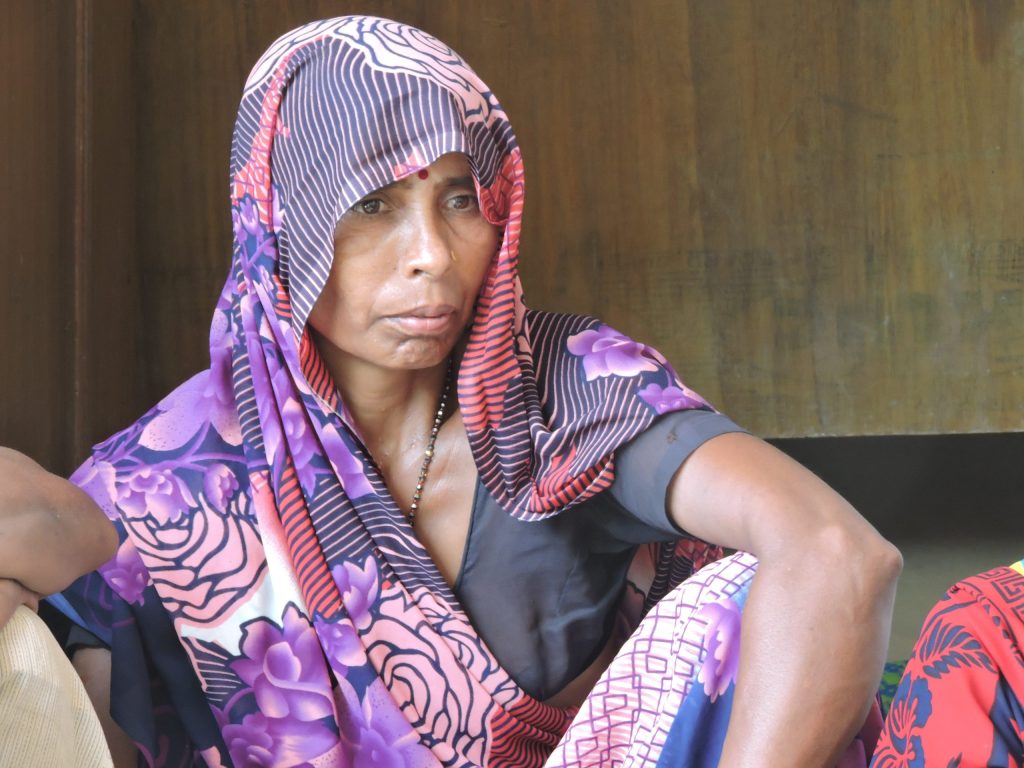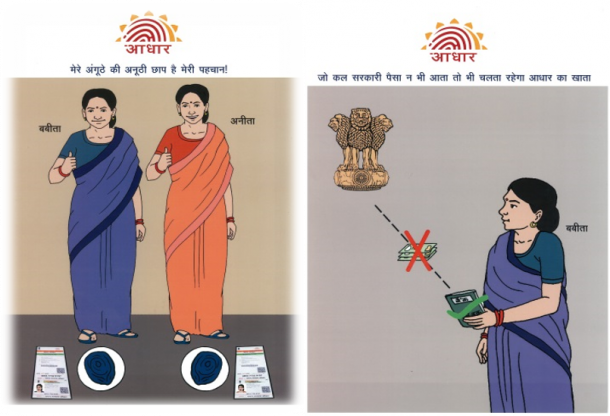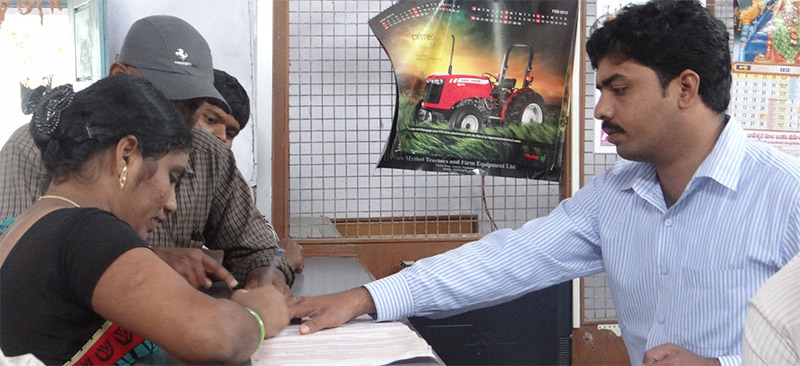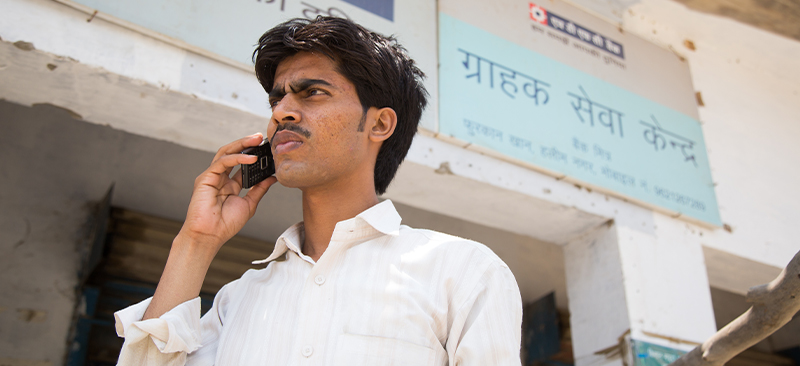This resource book can act as a useful guide to MFIs engaged in providing financial services to the poor, particularly agricultural finance; community based organisations engaged in aggregation of farm produce and other practitioners in the area of agricultural financing. The intended benefits of the resource book are to help the audience in understanding clients’ perspective, understand the concept of value chains and usage of the tool of value chain analysis, identify opportunities and develop these into a product concept, use pilot testing to gauge clients’ feedback on the product and its impact on organisation; and roll-out of the product successfully with known benefits and impacts.
Blog
Behavioural Insights in Insurance
It is a widely held belief amongst experts and industry players that, “Insurance is never bought, it is always sold”. Though, numerous research studies on insurance have focused on preference and willingness of consumers, the anomaly of demand and apathy of users remain one of the greatest mysteries of the financial world. This note takes an alternative view from the conventional wisdom of expected utility and optimum deductible in insurance to analyse user preference. Instead the note highlights explanations for insurance purchase and use decisions through concepts of behavioural economics. The note argues that use of these concepts along with thorough understanding of business dynamics of the insurance industry can alone lead to effective user centric designs in insurance and microinsurance.
Draft branchless banking regulations in Indonesia – A review
The Government of Indonesia has been proactive in its efforts to extend formal financial access to the unbanked and under-banked sections of the society. The release of draft regulations on branchless financial services for financial inclusion by Otoritas Jasa Keuangan (OJK – the financial services authority that regulates and supervises financial services activities in banking, capital markets, and non-bank financial industries) is a positive step in this direction. It is laudable that OJK has provided much needed regulatory clarity in such a short time. This note provides an analysis of the draft regulations based on our experience of working in Indonesia and other geographies.
Some of the positive and progressive clauses of the regulation are highlighted below.
- Stakeholder Feedback: OJK’s initiative to seek feedback from industry experts and stakeholders is commendable. Media reports also suggest that OJK plans to have discussions with industry players to seek their suggestions. These consultations provide much needed industry perspective, making it a collaborative effort to devise enabling regulations.
- Simpler Customer Due Diligence (CDD) Requirements: A client with any photo identity card issued by the government or a reference letter from a local community leader can open a basic savings account. This is the most progressive clause of the regulation. Simpler CDD requirements help the financially excluded sections of the society integrate into the formal financial system. For example in Pakistan (with simpler CDD requirements for low-value accounts), the number of branchless banking accounts grew 63% in a year, from 1.8 million in September 2012 to 2.96 million in September 2013. Further, this clause is in line with Financial Action Task Force’s guidance on AML/CFT measures for Financial Inclusion ensuring that the risks associated with simpler CDD requirements are not compromised.
- Diverse Product Suite: The regulations permit service providers to offer a wide array of products such as savings, micro-loans, micro-insurance, and transfers thus providing a one-stop shop for all clients’ financial needs. It is a well-documented fact that poor lead active financial lives because they are poor, not despite it. They create “portfolios” using various financial products through informal and formal institutions to address their immediate and longer-term needs. Research conducted by MicroSave in Indonesia and elsewhere(for example India, Bangladesh, Sri Lanka, and Nepal) shows that there is high demand for diverse financial products/services among the poor and the unbanked. A diverse product suite also drives up transaction volumes increasing business viability for service providers and agents.
- Varied Service Providers: Banks, financial institutions and insurance companies (life and asset) are eligible to become branchless financial service providers. This enables smaller banks and financial institutions (including microfinance, rural banks, and venture finance institutions) with limited capital and geographical presence to offer financial services through low-cost technology-enabled channels. Further, service providers are allowed to appoint individual agents (airtime sellers, mom and pop stores, etc.) and business entities (with legal status) as agents. This is a marked shift from existing electronic money regulations, issued by Bank Indonesia, which favor big Buku IV banks(banks with a minimum core capital of IDR 30 trillion i.e., approximately US$2.6 billion) by allowing them to appoint individual agents. Airtime sellers, small retailers, and mom and stores have played a significant role in facilitating low value/high volume financial transactions in other geographies. In Indonesia, both the organized and unorganized retail sectors have a significant presence. 75% to 80% of retail sales are through the unorganized sector, and reports also suggest that there are 2.56 million retailers in Indonesia. Clearly, these outlets can play a major role in reaching out to the unbanked and under-banked.
However, we would like to suggest some improvements to make the regulations more progressive and further foster the development of branchless financial services in Indonesia.
- Customer Charges: Regulations suggest customers can be charged for withdrawals and transfers only after four transactions in a month. All other transactions are free. The assumption behind these restrictions seems to be that customers may not willing or able to pay for the services. However, research done by MicroSave with Cocoa farmers in South Sulawesi indicates that customers are willing to pay up to IDR 5000 for withdrawals and IDR 2500 for bill payment transactions. Further findings from cost and willingness to pay research conducted in India suggest that an overwhelming 80% of the respondents are willing to pay for the services if they are closer, quick and easy (hassle free). Restrictions on charges are likely to render the business unviable both for service providers and agents. In a nationwide study conducted by MicroSave (findings of the research were presented in an exclusive workshop for OJK), respondents mentioned that commissions/incentives remain the biggest motivation to become an agent. Agents carry out key activities – customer enrolment, liquidity management, transaction facilitation etc. – and additional revenue in the form of incentives/commissions keep them motivated. Charging customers for enrolment, cash-outs, payments, and transfers make the digital financial services (DFS) viable and sustainable for all the stakeholders.
- Location restrictions: Regulations suggest that service providers need to have branches in the eastern part of Indonesia in order to be eligible for branchless financial services. Further regulations restrict agents from operating in provincial, regency or municipality capitals. Removing these clauses would help service providers realize the full potential of DFS deployments. Studies in all countries with successful DFS deployments show that agents are present both in urban and rural areas. For example, only 43% of M-PESA agents in Tanzania are located in rural areas and the rest in urban areas. Further GSMA’s State of the Industry 2013 (Mobile Financial Service for the Unbanked) study shows that 71% of the agents worldwide are in urban areas. Contrary to the common perception, there is very significant and important demand for such services even in urban areas. Proximity, convenient timing (early morning or late evening), less documentation and no queues are the reasons why customers prefer to conduct transactions with agents in urban areas. Research conducted by MicroSave in Indonesia suggests that 57% of the respondents like agents’ convenient timing as it allows them to transact before/after their work. Furthermore, those who have migrated to the cities for work need urban agents to remit money home into the rural areas. So removing this facility will weaken the value proposition for clients and remove a key anchor product for DFS providers.
- Withdrawal restrictions: A customer can withdraw only IDR 5 million (US$430) a month, even though he/she is allowed to maintain up to IDR 20 million (US$1,720) in the account. While the intentions seem noble (risk mitigation, AML/CFT measures and liquidity management), the consequences can be negative. Customers will want uninhibited access to their own funds at any point in time. Not providing this access will spoil customer experience leading to limited uptake. Personally, as customers, we would not be willing to save with a bank which restricts from withdrawing our own funds! The risks/frauds related to withdrawals at agent outlet are already taken care of as regulations mandate two-factor authentication. Further, OJK can mandate banks to note down customer identification number (KTP/SIM etc) for every agent initiated a transaction. This is already being practiced in Kenya and has been helpful in controlling frauds.
- Agent Exclusivity: Regulations mandate agents to partner with only one service provider. Agents should be given the option to partner with multiple service providers depending on the business potential he/she foresees in the area. Many of the regulators such as in Pakistan, Rwanda, Kenya etc. mandate non-exclusivity of agents (i.e. agents can partner with more than one bank/service provider). True financial inclusion can be achieved through non-exclusive agents, especially in rural areas where access to formal financial services is limited. Setting up exclusive agent networks in rural areas will also be more costly and unviable. In addition, we have observed that it is difficult to find qualified agents in rural areas given the limitations in term of capital, education level, ability to use technology, etc. Moreover, from the customer perspective, non-exclusive agents will provide a shared platform for a better customer uptake. Customers can choose the best product/services for them when they have a choice between various service providers. Agents can and indeed should act as financial supermarkets offering multiple products/ services through various service providers.
- Agent Association with Bank: The proposed regulations suggest that only existing customers associated with the bank/service provider for at least two years are eligible to become agents. It will be good if this requirement is relaxed or done away with. It can be a “good to have” criteria rather than a “disqualifying” criteria for recruiting agents. Otherwise, it will prevent many deserving, capable and willing candidates from becoming agents. Further OJK may direct banks/FIs to have their own agent selection criteria to ensure proper due diligence in the selection of agents. A case in point is branchless banking regulations in Pakistan where the central bank mandates the service providers to have new agent on-boarding procedure (NATP) as part of its Agent Due Diligence policy.
In conclusion, OJK has taken a giant leap towards achieving the objective of financial inclusion in Indonesia. However, to create a win-win situation for all the stakeholders, more importantly, customers, OJK may consider suggestions provided by MicroSave and other industry experts. For the service providers – the ball is in your court now! It is your turn to come up with viable, innovative and customer-centric branchless financial services business models that meet the needs of unbanked and under-banked Indonesians.
The Landscape of Microinsurance in Asia and Oceania 2013
Communication – The Achilles heel of direct benefit transfers – Part I
Imarti Devi is an 84-year-old widow in Magalsi village in Faizabad district, Uttar Pradesh, and receives an old age pension under the National Social Assistance Program (NSAP) each month-end. She has no idea of the actual date when she is supposed to receive her pension payment, but the Sarpanch (village head) usually (but not always) pays her pension in cash some time at the end of each month. If she does not receive the payment in any particular month, she receives the cumulative amount for 2-3 months the following month or the month after. She does not know why the payment is irregular. Imarti Devi does not count the cash she is given but goes back home satisfied when she receives money. She does not complain about anything.
Imarti’s story is not an exception but the rule about the plight of social benefits recipients in India. They are content and do not complain when and how they receive benefits under various G2P schemes. Possibly Imarti Devi and millions have grown used to, and to accept the way they are treated, and believe this is the way it is supposed to be. And do not raise objections, queries or complaints about fear of losing what benefits they receive.
Ever since Direct Benefit Transfer (DBT) was launched, an emphasis has been on operational issues such as bank account opening and linking the government department’s database and the beneficiaries’ bank accounts. The lack of “last mile transaction points” (typically the cash in/out agents) is discussed only sporadically. But the real situation is far from satisfactory, as is evident from recent studies undertaken by MicroSave about the status of CSPs and the state of agent readiness in selected districts.
The finer aspects of implementation have taken a backseat. One of these is communication. Surprisingly, “communication” has never become a center stage issue. No one seems to have considered that lack of communication could be one of the major reasons behind inconvenience caused to beneficiaries.
Not that it was completely ignored –Above The Line (ATL) communication media were used by some of the implementing agencies and intermediaries, but (at best) these were disjointed efforts. Atop down approach of communication was adopted with an assumption that once the implementation was in progress, information would automatically reach beneficiaries. Evidence shows that this led to a lot of misinformation amongst beneficiaries. In their hurry to get things done, agencies paid scant attention to ensuring the right messages were reaching the beneficiaries. Consequently, beneficiaries received different pieces of information from various sources. This left them confused and apprehensive of new schemes and processes.
This might be understandable for communities living in remote locations, or for illiterate segments, or those not having regular access to information media. However, the communication challenge is evident even in urban programmes, including, for example, Dilli Annashree Yojna. This scheme was launched in Delhi and covered population that is definitely more mobile, aware and media savvy than most parts of India. But, beneficiaries still faced issues due to lack of clear and comprehensive information about the scheme.
Sunita is a beneficiary for Aadhaar-based Dilli Annshree Yojana(DAY) under which she receives cash subsidy for food every month directly into her bank account. She is only aware of the amount of benefit she should receive every month. She opened a new account as directed by the bank and other government/ quasi-government agencies. She knows only as much as she was told by the staff and officials of these entities. She is hardly aware of:
- the eligibility for receiving such benefits,
- why she was supposed to open a new bank account,
- why was she asked to link her Aadhaar number to this account,
- whether she could have used her existing account to receive the benefits, and
- many other similar queries that she would like to know (or should have been told in the first place).
She is not aware because the ad-hoc communication never contained this information, and gave no option for her to ask questions. She did not try to seek more information, perhaps due to her reluctance to go to banks or government departments implementing such schemes. Or maybe it was lack of time.
The absence of proper communication has led to a lot of apprehension and myths in the mind of Sunita and many other beneficiaries like her. According to a study conducted by MicroSave, DAY beneficiaries used to withdraw all money from their account (opened for DBT under DAY) and never saved any money in these accounts.[1] Many beneficiaries confirmed that they were asked (by banks/ government agencies) not to leave any balance in these accounts. The logic given was that the government might take the money back on the basis that if they could leave money in their accounts, they are not poor enough to warrant benefits. After withdrawing the money from the benefit account, if the beneficiary wanted to save some portion of it, she had to save it in a separate account sometimes with the same bank, but in most cases with some other bank … or (more likely) secreted at home. Hardly the optimal recipe for financial inclusion!
At the same time during a similar study in rural hinterlands of Jharkhand, we discovered that all DBT beneficiaries did not withdraw the full amount, but invariably left some funds in their accounts. This was quite contrary to our initial assumption that city dwellers were more aware, better informed and therefore would use the DBT/saving account to save. When we dug deep we discovered that it was once again because “they were told to do so”. Beneficiaries in Jharkhand had been informed that if they did not keep funds, it would become inactive and thus they would no longer receive benefits.
Results of this study prove that DBT beneficiaries are doing whatever they think they should be doing in order to continue receiving funds – they do what they are “told”. Do beneficiaries really deserve such scant attention? Are they not supposed to be at the center of the delivery mechanism? What could have been done differently in order to make entire DBT experience more convenient and useful to beneficiaries? We believe the answer lies in effective and standard communication. This is discussed in the next blog.
[1] The study was conducted for a client, and therefore has not been published or available in the public domain.
Communication – The Achilles heel of direct benefit transfers – Part II
We strongly believe that an integrated communication approach should be the starting point of a large Direct Benefit Transfer (DBT) programs. It certainly helps to be as clear and succinct as possible to manage expectations. In the previous blog, we highlighted how poor and often contradictory communication is leading to mass confusion and apprehension amongst beneficiaries. In this blog, we present a case for beneficiary centric communication.
Is communication really a challenge?
The first step is to assess why communication is confusing to beneficiaries?
There are multiple entities and interlinked processes in the DBT delivery channel. This is, understandably, a real challenge for beneficiaries to understand.
For example, Sita Devi, a 45-year-old in Ramgarh district in Jharkhand, was supposed to receive MNREGS payments directly in her account from January 2013 onwards. Previously she used to receive her payments from the Sarpanch (village head) every fortnight.

However, it did not turn out to be that simple. She was asked to open a new bank account for which she was asked to visit the bank that was 12 km. from her village. She could not do this for long because she could not go by herself. When she finally reached the bank branch, she discovered that she was also required to bring along her job card to open the bank account. She had to wait for another three weeks before she could go back to the bank, but again her account could not be opened as she did not have proper KYC documents in place. Finally, after two months of running from pillar to post, she managed to open her account. All this while, she was not aware that there was one BC agent of the bank working in her Panchayat. This agent was just 2 km. from her village but having opened an account at the bank branch, she could not transact at an agent location.
Though now she had a bank account, she was using it only for withdrawals as she was not clear she could use it for other banking services such as savings or fund transfer. She assumed that it was the government’s account thus she should not leave any money in an account. Many others in the area were aware of agent location and services offered but were unsure whether they could open accounts to receive MNREGS or government benefits there.
Thus Sita’s is not an isolated case. Most of the DBT beneficiaries have faced/are facing similar challenges, for want of a proper communication strategy.
Successful examples from past
MicroSave worked on an assignment to improve communication to beneficiaries of Dilli Annshree Yojana (DAY) in Delhi. Under this scheme, beneficiaries receive the cash food subsidy directly in beneficiaries’ accounts based on Aadhaar authentication. The communication campaign prepared and delivered under the assignment had a far-reaching impact on the knowledge and awareness of beneficiaries of the scheme. Before the campaign, DAY beneficiaries had very little knowledge about the very basic issues such as:
- The need to open an account
- How linking such accounts to Aadhaar can help the payment of future benefits etc.
- Whether they are required to withdraw all money or can leave balances in the account
- Whether they needed separate accounts for the different DBT schemes
They were under an impression that DAY accounts cannot be used for personal savings; that one should not leave any money in the DAY accounts; and that different accounts were required for each benefit they received. These myths and apprehensions were removed after a comprehensive Financial Education (FE) module were developed and delivered to a representative sample of beneficiaries.
Particularly in the case of Delhi, the impact was evident when we compared the awareness of beneficiaries after the campaign. For example, 69 percent of sample beneficiaries believed that Government can access individual account and therefore if they save money in this account, the government might remove them from the beneficiary list. But after the campaign, this figure came down to only 26 percent of beneficiaries. Similarly, there was a substantial positive impact on their understanding of the utility of their account, the need for Aadhaar linking and so on.
The fundamental reason for the success of this campaign was its bottom-up approach. Rather than carpet bombing information, MicroSaveconducted a need assessment survey to understand the communication gap. Based on this assessment, communication content, media, and manner were decided. For example, MicroSave found that for this population segment, communication material should not be written, but pictorial, because the latter enhances understanding and retention of the message.
Examples of the few pictorial posters embedded here depict the user-centric approach of a campaign.

The results of the campaign prove that with beneficiary centric communication, a lot of pain can be prevented. This is a win-win proposition for all the stakeholders. The scale and scope of DAY communication campaign can be considered small, given the huge volumes in all G2P benefit schemes, but it can be customized and scaled up for a larger impact. The only thing we need to keep in mind throughout the exercise is that beneficiary must be at the center of all activities and decisions.





